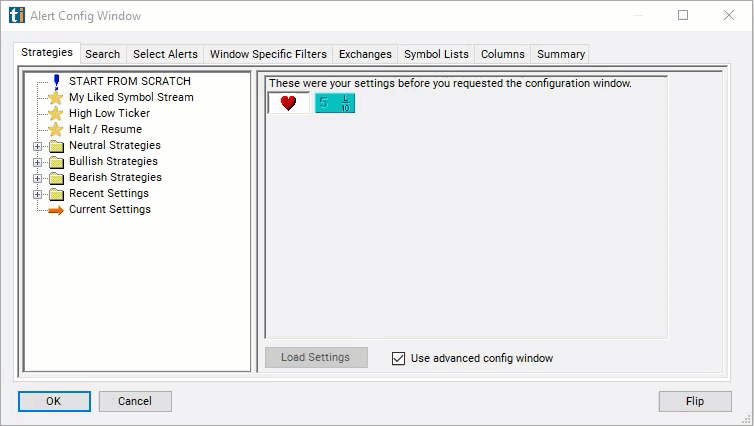Change From 20 Period SMA (2m)
Table of Contents
- Understanding the Change From 20 Period SMA 2 Minute Filter
- Change From 20 Period SMA 2 Minute Filter Settings
- Using the Change From 20 Period SMA 2 Minute Filter
- FAQs
Understanding the Change From 20 Period SMA 2 Minute Filter
The "Change From 20 Period SMA 2 Minute Filter" is a valuable tool for traders focusing on short-term intraday trading or scalping strategies. By comparing the current price of a stock to its 20-period Simple Moving Average (SMA) on a 2-minute chart, this filter provides insights into the stock's short-term momentum over the last 40 minutes. It helps traders identify potential entry and exit points based on changes in momentum within a single trading session.
Here’s an in-depth look at how this filter operates:
Simple Moving Average (SMA)
20-Period SMA on a 2-Minute Chart: Calculates the average of the closing prices for the last 20 two-minute periods, smoothing out price data over approximately the last 40 minutes of trading to identify short-term trends.
Calculation: The filter expresses its values in percentage (%), following the formula: Percent Change = ((Last Price - SMA) / SMA) * 100.
A positive result suggests that the stock's current price is above its 20-period SMA, indicating a potential uptrend. Conversely, a negative result indicates that the current price is below the SMA, suggesting a potential downtrend.

Change From 20 Period SMA 2 Minute Filter Settings
Configuring the "Change From 20 Period SMA 2 Minute Filter" is simple and can be done within the Window Specific Filters Tab of the Configuration Window in your Alert/Top List Window.
Here's how to set up the filter in your configuration window:
-
Adjust the minimum value to 1 to filter for stocks currently positioned above their 20-period SMA on a 2-minute chart.
-
Set the maximum value to -1 to focus on stocks currently below their 20-period SMA on a 2-minute chart.

Using the Change From 20 Period SMA 2 Minute Filter
The "Change From 20 Period SMA 2 Minute Filter" can be used in various trading strategies, including:
Trend Following Strategy: Enter trades in the direction of the prevailing trend indicated by the relationship between the current price and the 20-period SMA. Buy when the current price is above the 20-period SMA, indicating an uptrend, and sell when the price is below the SMA, indicating a downtrend.
Pullback Trading Strategy: Look for opportunities to enter trades on pullbacks within the context of the overall trend. Wait for the price to temporarily move below the 20-period SMA during an uptrend or above the SMA during a downtrend before entering a trade, anticipating a continuation of the trend.
Breakout Trading Strategy: Identify potential breakout opportunities when the price breaks decisively above or below the 20-period SMA. Enter trades when the price breaks above the 20-period SMA during an uptrend or below the SMA during a downtrend, anticipating a continuation of the breakout momentum.
Reversal Trading Strategy: Look for potential trend reversals when the price significantly deviates from the 20-period SMA. Enter trades when the price exhibits extreme deviations from the SMA, anticipating a reversal to the mean. For example, buy when the price is significantly below the SMA during an uptrend or sell when the price is significantly above the SMA during a downtrend.
FAQs
How does the "Change From 20 Period SMA (2 min)" filter differ from longer timeframe versions?
- The 2-minute version provides insights into short-term intraday momentum, whereas longer timeframe versions offer perspectives on broader trends over extended periods.
Is the "Change From 20 Period SMA (2 min)" filter suitable for all traders?
- This filter is most suitable for traders focusing on short-term intraday trading or scalping strategies. Traders with longer-term investment horizons may find longer timeframe versions more relevant.
How should I interpret significant positive or negative changes from the 20-period SMA on a 2-minute chart?
- Significant positive changes suggest upward momentum and potential buying opportunities, while significant negative changes indicate downward momentum and potential selling opportunities. However, always use additional indicators for confirmation.
How can I adjust the filter for stocks with different levels of volatility?
- Adjusting the percentage change threshold based on a stock's volatility can help tailor the filter's sensitivity, allowing traders to focus on significant momentum shifts while filtering out noise in highly volatile stocks.
Filter Info for Change From 20 Period SMA (2m) [2SmaLa20]
- description = Change from 20 Period SMA (2m)
- keywords = Fixed Time Frame Moving Average
- units = %
- format = 1
- toplistable = 1
- parent_code =





 Change from 20 Period SMA (5m) [5SmaLa20]
Change from 20 Period SMA (5m) [5SmaLa20] Change from 20 Period SMA (15m) [15SmaLa20]
Change from 20 Period SMA (15m) [15SmaLa20] Change from 20 Period SMA (60m) [60SmaLa20]
Change from 20 Period SMA (60m) [60SmaLa20]